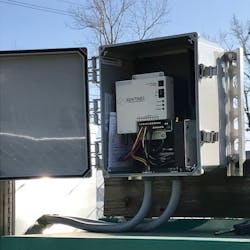Managing a wastewater treatment facility is a lot of responsibility. If pumps malfunction or power fails, wastewater can overflow. And if a pump fails for a long period of time and it goes unnoticed, the damage can be catastrophic, crippling wastewater treatment altogether. Equipment such as motors, electrical panels and other pumps can be destroyed, releasing untreated water to the surrounding homes and businesses. Because the flood of untreated water is a health risk, the facility and affected areas would need to be cleaned and sanitized.
Prevention and early detection are keys to keeping wastewater facilities operating smoothly. No one knows this better than Tom Jordan, plant manager at Bass Lake Conservancy District (BLCD) in Knox, Ind. BLCD owns and operates the sewer system that services the residents of Bass Lake, Ind., and the facility collects, treats and disposes of sewage and other liquid wastes.
“I'm responsible for making sure the plant and equipment are operating safely and efficiently,” Jordan said. “I'm also in charge of keeping the plant in regulatory compliance.”
A One-Person Operation
The BLCD wastewater facility has 16 lift stations with two pumps, each located around Bass Lake. These lift stations pump the wastewater from one pump to the next until it reaches the plant. These stations are designed to overcome gravity and boost the wastewater through the collection system. Because Jordan is the only full-time plant employee, it is up to him to drive the 11 miles around the lake every day to check on the stations.
Jordan monitors each station for water level, pump failure and power outage. Until recently, the BLCD alert system consisted of a horn and a flashing light that were activated when a pump malfunctioned. If Jordan was away from the premises, he relied on the public to notice the alarm and call him, hopefully before a serious backup occurred. Clearly, this is not a reliable system, especially because the population in the lake community decreases by about 75% in the winter months.
A More Efficient, Convenient Monitoring System
Fortunately for Jordan, last year he got approval from the board to take bids for a modern, proactive monitoring system. With the help of Jerry Gouker of Flow-Technics Inc., Jordan purchased and installed a Sensaphone Sentinel cellular monitoring system at each of the 16 lift stations.
The sensors are wired into relays off of the pump panels, and the Sentinel units are mounted outside of the lift stations in the weatherproof NEMA 4X enclosures that come with the devices. They communicate via cellular network and store data in the cloud for easy retrieval from any mobile device.
Now Jordan can spend his time on more important things than visiting lift stations every day. Instead, he can keep an eye on the entire operation from his computer and smartphone. He can conveniently change the sensor settings, read and adjust temperature limits, and acknowledge alarms from a Sensaphone app on his phone.
“The app is great because even when I'm home or off site, I can check on the conditions at the plant and lift stations,” Jordan said. “And if there's a possible problem, I can head over to the site or send one of the part-time people to take care of it before it becomes a disaster.”
Jordan chose the Sentinel cellular systems because they provide all the functionality he needs at low prices. They also offer a 4G connection, which is important because cellular network providers such as Verizon and AT&T are phasing out 3G support. That means BLCD will not need to worry about upgrading the system in the near future.
[Visit Sensaphone's WWD Storefront]
The system also automates the recordkeeping and reporting that Jordan is required to do to maintain compliance with the Indiana Department of Environmental Management. That is because the cloud-based system also is a data acquisition device that has unlimited storage and lets users view, graph, print and export information.
But most of all, the new monitoring system brings peace of mind to Jordan and the local community.
“In the winter, it’s nice to just be able to bring up the data log on the computer and see all green, meaning everything is good,” Jordan said.



